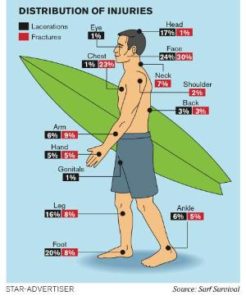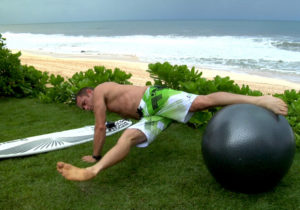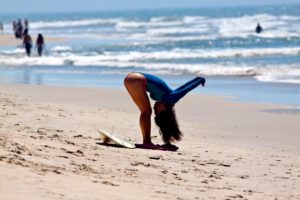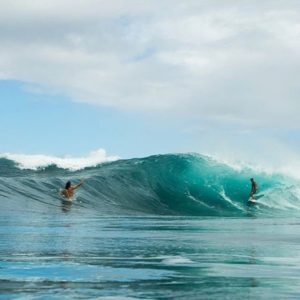
Article review by Glenn T Goodwin, PhD, DABFE
 Its the summer flats, but there could be a bump on the horizon and sooner or later you know what’s coming. So don’t get lazy, but get crazy with your conditioning. Here is an informative read from Pedro Seixas at The Inertia.
Its the summer flats, but there could be a bump on the horizon and sooner or later you know what’s coming. So don’t get lazy, but get crazy with your conditioning. Here is an informative read from Pedro Seixas at The Inertia.
“We are facing a new era in surfing. Every day, surfers push their limits with everything from high performance aerials to charging big waves in remote locations. Meanwhile, the industry works to follow this evolution of the sport. They give us lighter and faster boards, warmer and more flexible wetsuits, and better equipment for every phase of finding and surfing bigger and bigger waves.
However, no matter how good our gear gets we are far from being indestructible Gods. We surf on top of an object that can change from toy to weapon in seconds – all in an environment that we can’t control – simply because it gives us the best feeling in the world.
At the highest level, we are seeing more WSL pros sent to rehab more often. On the opposite end of the spectrum, even weekend warriors are not safe. Digging into the 2013 injury update of the WSL (former ASP), we can tell that 12 of the 34 top surfers suffered a range of injuries that kept them out of competition to some degree, with an average time of three months spent out of competition. The affected areas were the ankle/ foot (six surfers), the knee (three), the back (two), and shoulder (one). In Portugal, I’ve conducted my own survey among 500 Portuguese surfers, finding that 78.5% of them had already sustained at least one significant surf-related injury, with an average of 1.62 injuries/year and 43,9% getting re-injured.
This isn’t simply cuts a nd bruises. In fact only 37.5% of injuries represent “cuts or lacerations,” showing that 76.3% are musculoskeletal injuries (muscle stiffness, sprain/ torn muscles, joint dislocations, etc.) Surfer’s ear, feet lacerations and even hypothermia can only be prevented passively, trough the use of appropriate gear like earplugs, booties or a good wetsuit; However, we can still do plenty to prevent musculoskeletal injuries. This kind of injury can occur through:
nd bruises. In fact only 37.5% of injuries represent “cuts or lacerations,” showing that 76.3% are musculoskeletal injuries (muscle stiffness, sprain/ torn muscles, joint dislocations, etc.) Surfer’s ear, feet lacerations and even hypothermia can only be prevented passively, trough the use of appropriate gear like earplugs, booties or a good wetsuit; However, we can still do plenty to prevent musculoskeletal injuries. This kind of injury can occur through:
– sustained postures, with stabilizing muscles overload (e.g. extension of the spine when paddling).
– overuse or gesture repetition, after an intense effort in a short period of time (like flexion and rotation of the knees and torso when maneuvering).
– impact of the wave and board versus the body (e.g. snapping the lip) or body over the board (e.g. landing a floater/ aerial).
– overuse without recovering or proper resting (e.g. surfing three days straight without stretching).
So here is the why, where, when, who of it… taking preventative measures (stretching, training, etc.)
Why
 Why not? The one thing that’s worse than surviving a flat spell is being kept out of the water when it’s pumping because you’ve been injured. The physical demand of surfing combined with standing/paddling transitions (explosive effort), associated arms movement (take off, paddling) and legs (trimming, bottom turn) and the number of hours spent surfing, lead to decreasing performance and riding of fatigue levels in your body while surfing. This diminishes neuromuscular control and exposes the surfer to a higher probability of occurring an injury.
Why not? The one thing that’s worse than surviving a flat spell is being kept out of the water when it’s pumping because you’ve been injured. The physical demand of surfing combined with standing/paddling transitions (explosive effort), associated arms movement (take off, paddling) and legs (trimming, bottom turn) and the number of hours spent surfing, lead to decreasing performance and riding of fatigue levels in your body while surfing. This diminishes neuromuscular control and exposes the surfer to a higher probability of occurring an injury.
Where
At the gym: trough specific functional surf training, simulating surfing moves/ patterns that you do when surfing, using unstable platforms, medicine balls, elastic bands, etc. At home: where you can have your own mini gym with a simple medicine ball and some elastic bands.
For competitors: during a surf contest: using the recommended physiotherapist at your disposal to help with some dynamic warm up exercises before your heat or muscular recovery and stretching after.
When
Before surfing: with a good warm-up from head to toes, focusing on combined flexion/ extension and rotati on movements that put more stress and overload to the main structures in our body. After surfing: with a complete stretching session going trough the main muscular groups involved in surfing.
on movements that put more stress and overload to the main structures in our body. After surfing: with a complete stretching session going trough the main muscular groups involved in surfing.
Who
Everyone! Whether you’re a weekend warrior, a regular at your home break, a kid starting to compete, or a pro surfer – everyone should do some kind of specific training as an injury prevention tool. The difference in the type of training you do, according to the intensity, duration and frequency, should be based on your goals in surfing, age, fitness/ health condition and previous injuries.
After all this, if you still have doubts on initiating an injury prevention routine, take it from Mick Fanning after learning the hard way: “For me, training is a lot of injury prevention. I started training super seriously when I got injured.”
















